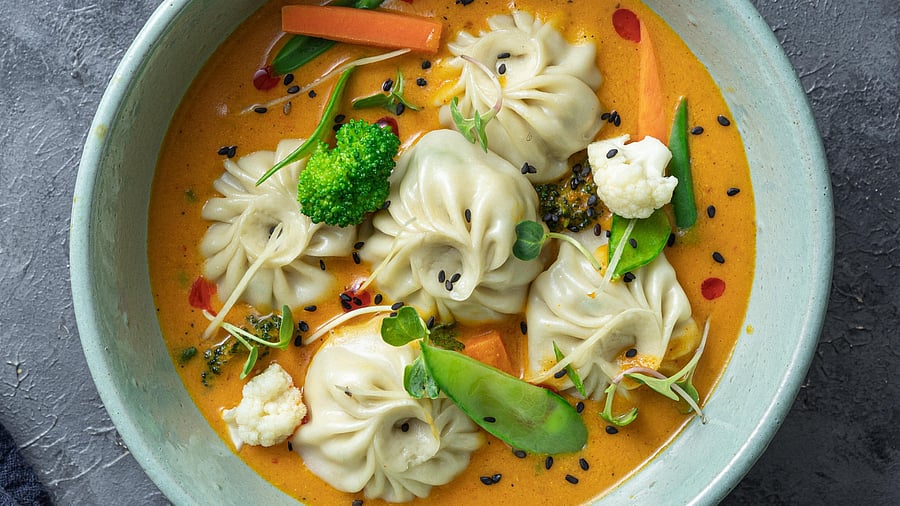
Thukpa.
Credit: Pixabay
As the perfect example to debunk the notion of a mono-cultural “Indian food” scene, Ladakhi cuisine is as unique as it is flavourful and texture-packed. Each bite and sip offers a new sensation to those who are lucky to partake in its exotic novelty. Characterised by the plentiful use of carbohydrates, mild flavours and delicate textures, this high-altitude cuisine of one of India’s most unique regions leans heavily towards the use of indigenous ingredients and cooking techniques. And given its geography and terrain — one that’s often cut off from the rest of India for extended periods — this uniqueness and self-reliance makes a whole lot of sense...
Full steam ahead!
Take for example the most ubiquitous of all Ladakhi dishes, the momo. Now, this specimen isn’t the same as we’ve been used to eating in the rest of India. Heavily influenced by the Tibetan style of making a dumpling, the meat and vegetables-stuffed Ladakhi momo features a slightly thicker wheat flour outer coating that’s shaped in both a round pleated bun and a more common half-moon. Served to guests on special occasions such as the Losar festival (Ladakhi New Year), momos are steamed in a container called mokto which has several compartments with holes in them and placed on top of each other.
Also steamed in a mokto is the glossy, wheat flour-coiled bun called tingmo. This one too is a Tibetan “hand-me-down” carb side dish that is used to mop up gravies or to dunk in a cup of salted butter tea that is onomatopoeically called gur-gur chai.
Dairy good
Here, red tea is boiled till very strong and then yak butter and salt get thrown in sans any milk. In Ladakh, people drink butter tea while tucking into a sha balep to keep themselves warm and toasty on a frigid winter’s day. Also known as sha phaley, this is also a Tibetan dish of bread stuffed with seasoned meat and cabbage. Just like a Cornish pasty or a South American empanada, it is then fashioned into semi-circular or circular shapes and according to regional variations is either deep-fried or pan-fried like a Japanese gyoza or a Chinese pot sticker dim sum.
But undoubtedly, the most common accompaniment to gur-gur chai is khambir. Often known as just tagi (bread), this is a local whole wheat brown bread with a thick crust. Often baked in rounds, this fermented bread is served for breakfast slathered with the delicious apricot jam that’s another regional speciality. People also eat khambir after a week when it gets a bit dry and is perfect for dunking in warm yak milk.
Another ‘edible warmer’ in Ladakh is the yak cheese called churrpi. Made from fresh yak milk, churrpi has two iterations: hard and soft. This depends on how much it has been dried. Rich in protein, churrpi also contains omega-3 fatty acids and antioxidants and is a good source of calcium, phosphorus, magnesium, zinc, and vitamins A, B, D, and E.
Pasta perfect
In Ladakh, there is an interesting, almost pasta-like duo of indigenous noodles that take the top spot in the list of savoury dishes made here. The first one is called kyu and it is made from wheat dough and cooked in a warming stew along with yak meat. Chhutagi, another Ladakhi dumpling that came to the region via the Silk Road from Central Asia, is a bow tie-shaped dumpling (much like the Italian farfalle pasta) used in a soup that is made from meat and vegetables and is similar to thukpa. Chhutagi literally translates as “water bread” (chhu means “water” while tagi is “bread” in Ladakhi as mentioned earlier). But this carb fest isn’t all about the savoury, Ladakhi cuisine is also known for its sweet dumpling called pakchel mirku that is cooked into a warming dessert along with ghee and yes, more churrpi!
Circling back to the other popular regional speciality of thukpa, in Ladakh this one is a much celebrated, fortifying dish. A very simple meat, noodles and vegetable soup that is rich in spices like chilli and cumin powders, along with the mouth-tingling Sichuan pepper, this one not only satiates the taste buds but also warms the body. There are different types of thukpa (known as thentuk, pakthuk) served in different parts of Ladakh. Each is slightly different from the other, but all equally scrumptious. But that’s exactly how Ladakhi cuisine is. Unique and exotic, while also being wholesome and satiating. Down to every last bite and sip!